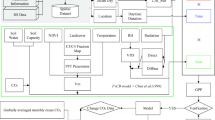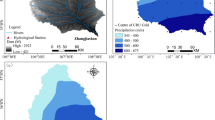Abstract
Using a process-based model, I assessed how ecophysiological processes would respond to near-future global changes predicted by coupled atmosphere–ocean climate models. An ecosystem model, Vegetation Integrative SImulator for Trace gases (VISIT), was applied to four sites in East Asia (different types of forest in Takayama, Tomakomai, and Fujiyoshida, Japan, and an Alpine grassland in Qinghai, China) where observational flux data are available for model calibration. The climate models predicted +1–3°C warming and slight change in annual precipitation by 2050 as a result of an increase in atmospheric CO2. Gross primary production (GPP) was estimated to increase substantially at each site because of improved efficiency in the use of water and radiation. Although increased respiration partly offset the GPP increase, the simulation showed that these ecosystems would act as net carbon sinks independent of disturbance-induced uptake for recovery. However, the carbon budget response relied strongly on nitrogen availability, such that photosynthetic down-regulation resulting from leaf nitrogen dilution largely decreased GPP. In relation to long-term monitoring, these results indicate that the impacts of global warming may be more evident in gross fluxes (e.g., photosynthesis and respiration) than in the net CO2 budget, because changes in these fluxes offset each other.








Similar content being viewed by others
References
Ainsworth EA, Rogers A (2007) The response of photosynthesis and stomatal conductance to rising [CO2]: mechanisms and environmental interactions. Plant Cell Environ 30:258–270
Amthor JS (1991) Respiration in a future, higher CO2 world. Plant Cell Environ 14:13–20
Asner GP, Scurlock JMO, Hicke JA (2003) Global synthesis of leaf area index observations: implications for ecological and remote sensing studies. Glob Ecol Biogeogr 12:191–205
Badeck F-W, Bondeau A, Böttcher K, Doktor D, Lucht W, Schaber J, Sitch S (2004) Responses of spring phenology to climate change. New Phytol 162:295–309
Boer GJ, Yu B, Kim S-J, Flato GM (2004) Is there observational support for an El Niño-like pattern of future global warming? Geophys Res Lett 31:L06201. doi:10.1029/2003GL018722
de Pury DGG, Farquhar GD (1997) Simple scaling of photosynthesis from leaves to canopies without the errors of big-leaf models. Plant Cell Environ 20:537–557
Doi H, Takahashi M (2008) Latitudinal patterns in the phenological responses of leaf colouring and leaf fall to climate change in Japan. Glob Ecol Biogeogr 17:556–561
Emori S, Hasegawa A, Suzuki T, Dairaku K (2005) Validation, parameterization dependence, and future projection of daily precipitation simulated with a high-resolution atmospheric GCM. Geophys Res Lett 32:L06708. doi:10.1029/2004GL022306
Farquhar GD, von Caemmerer S, Berry JA (1980) A biochemical model of photosynthetic CO2 assimilation in leaves of C3 species. Planta 149:78–90
Field CB, Jackson RB, Mooney HA (1995) Stomatal responses to increases CO2: implications from the plant to global scale. Plant Cell Environ 18:1214–1225
Foley JA, Costa MH, Delire C, Ramankutty N, Snyder P (2003) Green surprise? How terrestrial ecosystems could affect earth’s climate. Front Ecol Environ 1:38–44
Hamilton JG, Thomas RB, Delucia EH (2001) Direct indirect effects of elevated CO2 on leaf respiration in a forest ecosystem. Plant Cell Environ 24:975–982
Hikosaka K, Onoda Y, Kinugasa T, Nagashima H, Anten NPR, Hirose T (2005) Plant responses to elevated CO2 concentration at different scales: leaf, whole plant, canopy, and population. Ecol Res 20:243–253
Hirata R, Hirano T, Saigusa N, Fujinuma Y, Inukai K, Kitamori Y, Takahashi Y, Yamamoto S (2007) Seasonal and interannual variations in carbon dioxide exchange of a temperate larch forest. Agric For Meteorol 147:110–124
Hirata R, Saigusa N, Yamamoto S, Ohtani Y, Ide R, Asanuma J, Gamo M, Hirano T, Kondo H, Kosugi Y, Li S-G, Nakai Y, Takagi K, Tani M, Wang H (2008) Spatial distribution of carbon balance in forest ecosystem across East Asia. Agric For Meteorol 148:761–775
Hirose T, Ackerly DD, Traw MB, Damseier D, Bazzaz FA (1997) CO2 elevation, canopy photosynthesis, and optimal leaf area index. Ecology 78:2339–2350
Ichii K, Suzuki T, Kato T, Ito A, Hajima T, Ueyama M, Sasai T, Hirata R, Saigusa N, Ohtani Y, Takagi K (2009) Multi-model analysis of terrestrial carbon cycles in Japan: reducing uncertainties in model outputs among different terrestrial biosphere models using flux observations. Biogeosci Discuss 6:8455–8502
Intergovernmental Panel on Climate Change (IPCC) (2000) Special report on emissions scenarios. Cambridge University Press, Cambridge
Intergovernmental Panel on Climate Change (IPCC) (2007) Climate change 2007: the physical science basis. Cambridge University Press, Cambridge
Ito A (2008) The regional carbon budget of East Asia simulated with a terrestrial ecosystem model and validated using AsiaFlux data. Agric For Meteorol 148:738–747
Ito A, Oikawa T (2002) A simulation model of the carbon cycle in land ecosystems (Sim-CYCLE): a description based on dry-matter production theory and plot-scale validation. Ecol Model 151:147–179
Ito A, Oikawa T (2006) Absorption of photosynthetically active radiation, dry matter production, and light-use efficiency of terrestrial vegetation: a global model simulation. In: Kawahata H, Awaya Y (eds) Global Climate change and response of carbon cycle in the equatorial Pacific and Indian oceans and adjacent landmasses, vol 73. Elsevier, Amsterdam, pp 335–359
Ito A, Inatomi M, Mo W, Lee M, Koizumi H, Saigusa N, Murayama S, Yamamoto S (2007) Examination of model-estimated ecosystem respiration by use of flux measurement data from a cool-temperate deciduous broad-leaved forest in central Japan. Tellus 59B:616–624
Kato T, Tang Y (2008) Spatial variability and major controlling factors of CO2 sink strength in Asian terrestrial ecosystems; evidence from eddy covariance data. Glob Chang Biol 14:2333–2348
Kato T, Tang Y, Gu S, Hirota M, Du M, Li Y, Zhao X (2006) Temperature and biomass influences on interannual changes in CO2 exchange in an alpine meadow on the Qinghai-Tibetan Plateau. Glob Chang Biol 12:1285–1298
Kira T (1991) Forest ecosystems of east and southeast Asia in a global perspective. Ecol Res 6:185–200
Kistler R, Kalnay E, Collins W, Saha S, White G, Woollen J, Chelliah M, Ebisuzaki W, Kanamitsu M, Kousky V, van den Dool H, Jenne R, Fiorino M (2001) The NCEP-NCAR 50-year reanalysis: monthly means CD-ROM and documentation. Bull Am Meteorol Soc 82:247–267
Kitao M, Koike T, Tobita H, Maruyama Y (2005) Elevated CO2 and limited nitrogen nutrition can restrict excitation energy dissipation in photosystem II of Japanese white birch (Betula platyphylla var. japoninca) leaves. Physiol Plant 125:64–73
Leuning R (1995) A critical appraisal of a combined stomatal-photosynthesis model for C3 plants. Plant Cell Environ 18:339–355
Lloyd J, Taylor JA (1994) On the temperature dependence of soil respiration. Funct Ecol 8:315–323
Long SP, Ainsworth EA, Rogers A, Ort DR (2004) Rising atmospheric carbon dioxide: plants FACE the future. Annu Rev Plant Biol 55:591–628
Luo Y, Gerten D, Le Maire G, Parton WJ, Weng E, Zhou X, Keough C, Beier C, Ciais P, Cramer W, Dukes JS, Emmett B, Hanson PJ, Knapp A, Linder S, Nepstad D, Rustad L (2008) Modeled interactive effects of precipitation, temperature, and [CO2] on ecosystem carbon and water dynamics in different climatic zones. Glob Chang Biol 14:1986–1999
McMurtrie RE, Wang Y-P (1993) Mathematical models of the photosynthetic response of tree stands to rising CO2 concentrations and temperatures. Plant Cell Environ 16:1–13
Mikolajewicz U, Gröger M, Maier-Reimer E, Schurgers G, Vizcaíno M, Winguth AME (2007) Long-term effects of anthropogenic CO2 emissions simulated with a complex earth system model. Clim Dyn 28:599–633
Monsi M, Saeki T (2005) On the factor light in plant communities and its importance for matter production. Ann Bot 95:549–567
Muraoka H, Koizumi H (2005) Photosynthetic and structural characteristics of canopy and shrub trees in a cool-temperate deciduous broad-leaved forest: implications to the ecosystem carbon gain. Agric For Meteorol 134:39–59
Nasahara KN, Muraoka H, Nagai S, Mikami H (2008) Vertical integration of leaf area index in a Japanese deciduous broad-leaved forest. Agric For Meteorol 148:1136–1146
Norby RJ, Delucia EH, Gielen B, Calfapietra C, Giardina CP, King JS, Ledford J, McCarthy HR, Moore DJ, Ceulemans RD, De Angelis P, Finzi AC, Karnosky DF, Kubiske ME, Lukac M, Pregitzer KS, Scarascia-Mugnozza GE, Schlesinger WH, Oren R (2005) Forest response to elevated CO2 is conserved across a broad range of productivity. Proc Natl Acad Sci USA 102:18052–18056
Ohtani Y, Saigusa N, Yamamoto S, Mizoguchi Y, Watanabe T, Yasuda Y, Murayama S (2005) Characteristics of CO2 fluxes in cool-temperate coniferous and deciduous broadleaf forests in Japan. Phyton 45:73–80
Oikawa T (1986) Simulation of forest carbon dynamics based on dry-matter production model: 3. Effects of increasing CO2 upon a tropical rainforest ecosystem. Bot Mag 99:419–430
Ollinger SV, Richardson AD, Martin ME, Hollinger DY, Frolking SE, Reich PB, Plourde LC, Katul GG, Munger JW, Oren R, Smith M-L, KT PawU, Bolstad PV, Cook BD, Day MC, Martin TA, Monson RK, Schmid HP (2008) Canopy nitrogen, carbon assimilation, and albedo in temperate and boreal forests: Functional relations and potential climate feedbacks. Proc Natl Acad Sci USA 105:19336–19341
Parmesan C (2006) Ecological and evolutionary responses to recent climate change. Annu Rev Ecol Evol Syst 37:637–669
Piao S, Ciais P, Friedlingstein P, Peylin P, Reichstein M, Luyssaert S, Margolis H, Fang J, Barr A, Chen A, Grelle A, Hollinger DY, Laurila T, Lindroth A, Richardson AD, Vesala T (2008) Net carbon dioxide losses of northern ecosystems in response to autumn warming. Nature 451:49–52
Piao S, Fang J, Ciais P, Peylin P, Huang Y, Sitch S, Wang T (2009) The carbon balance of terrestrial ecosystems in China. Nature 458:1009–1013
Ryan MG (1991) Effects of climate change on plant respiration. Ecol Appl 1:157–167
Saigusa N, Yamamoto S, Murayama S, Kondo H (2005) Inter-annual variability of carbon budget components in an AsiaFlux forest site estimated by long-term flux measurements. Agric For Meteorol 134:4–16
Saigusa N, Yamamoto S, Hirata R, Ohtani Y, Ide R, Asanuma J, Gamo M, Hirano T, Kondo H, Kosugi Y, Li S-G, Nakai Y, Takagi K, Tani M, Wang H (2008) Temporal and spatial variations in the seasonal patterns of CO2 flux in boreal, temperate, and tropical forests in East Asia. Agric For Meteorol 148:700–713
Sitch S, Smith B, Prentice IC, Arneth A, Bondeau A, Cramer W, Kaplan JO, Levis S, Lucht W, Sykes MT, Thonicke K, Venevsky S (2003) Evaluation of ecosystem dynamics, plant geography and terrestrial carbon cycling in the LPJ dynamic global vegetation model. Glob Chang Biol 9:161–185
Thornton PE, Lamarque J-F, Rosenbloom NA, Mahowald NM (2007) Influence of carbon-nitrogen cycle coupling on land model response to CO2 fertilization and climate variability. Global Biogeochem Cycles 21:GB4018. doi:10.1029/2006GB002868
Woodward FI, Thompson GB, McKee IF (1991) The effects of elevated concentrations of carbon dioxide on individual plants, populations, communities and ecosystems. Ann Bot 67:23–38
Acknowledgments
This study was partly supported by Grants-in-Aid for Scientific Research from the Japan Society for the Promotion of Science (no. 19310017) and from the Japan Ministry of Education, Culture, Sports, Science and Technology (no. 21114010). This is a contribution to the A3 Foresight Program “Quantifying and predicting terrestrial carbon sinks in East Asia: toward a network of climate change research”.
Author information
Authors and Affiliations
Corresponding author
Rights and permissions
About this article
Cite this article
Ito, A. Changing ecophysiological processes and carbon budget in East Asian ecosystems under near-future changes in climate: implications for long-term monitoring from a process-based model. J Plant Res 123, 577–588 (2010). https://doi.org/10.1007/s10265-009-0305-x
Received:
Accepted:
Published:
Issue Date:
DOI: https://doi.org/10.1007/s10265-009-0305-x




